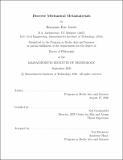Discrete mechanical metamaterials
Author(s)
Jenett, Benjamin(Benjamin Eric)
Download1249700492-MIT.pdf (27.20Mb)
Other Contributors
Program in Media Arts and Sciences (Massachusetts Institute of Technology)
Advisor
Neil Gershenfeld.
Terms of use
Metadata
Show full item recordAbstract
Digital fabrication enables complex designs to be realized with improved speed, precision, and cost compared to manual techniques. Additive manufacturing, for example, is one of the leading methods for rapid prototyping and near net shape part production. Extension to full scale structures and systems, however, remains a challenge, as cost, speed and performance present orthogonal objectives that are inherently coupled to limited material options, stochastic process errors, and machine-based constraints. To address these issues, this thesis introduces new materials that physically embody attributes of digital systems, scalable methods for automating their assembly, and a portfolio of use cases with novel, full-scale structural and robotic platforms. First, I build on the topic of discrete materials, which showed a finite set of modular parts can be incrementally and reversibly assembled into larger functional structures. I introduce a new range of attainable properties, such as rigidity, compliance, chirality, and auxetic behavior, all within a consistent manufacturing and assembly framework. These discretely assembled mechanical metamaterials show global continuum properties based on local cellular architectures, resulting in a system with scalability, versatility, and reliability similar to digital communication and computation. Next, I present a new kind of material-robot system to enable methods of assembly automation. Rather than relying on global motion control systems for precision, mobile robots are designed to operate relative to their discrete material environment. By leveraging the embedded metrology of discrete materials, these relative robots have reduced complexity without sacrificing extensibility, enabling the robots to build structures larger and more precise than themselves. Multi-robot assembly is compared to stationary platforms to show system benefits for cost and throughput at larger scales. Finally, I show a range of discretely assembled systems that blur the boundary between structure and robotics. Full-scale demonstrations include statically reconfigurable bridges, supermileage racecars, and morphing aero and hydrodynamic vehicles. Performance scaling is projected to new regimes, using case studies of turbine blades, airships, and space structures. These discrete systems demonstrate new, disruptive capabilities not possible within the limits of traditional manufacturing.
Description
Thesis: Ph. D., Massachusetts Institute of Technology, School of Architecture and Planning, Program in Media Arts and Sciences, September, 2020 Cataloged from the official PDF version of thesis. Includes bibliographical references (pages 127-136).
Date issued
2020Department
Program in Media Arts and Sciences (Massachusetts Institute of Technology)Publisher
Massachusetts Institute of Technology
Keywords
Program in Media Arts and Sciences